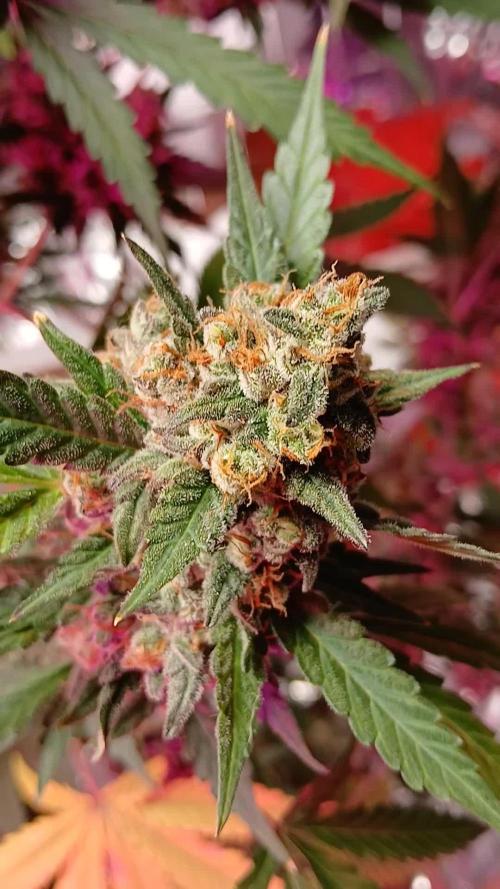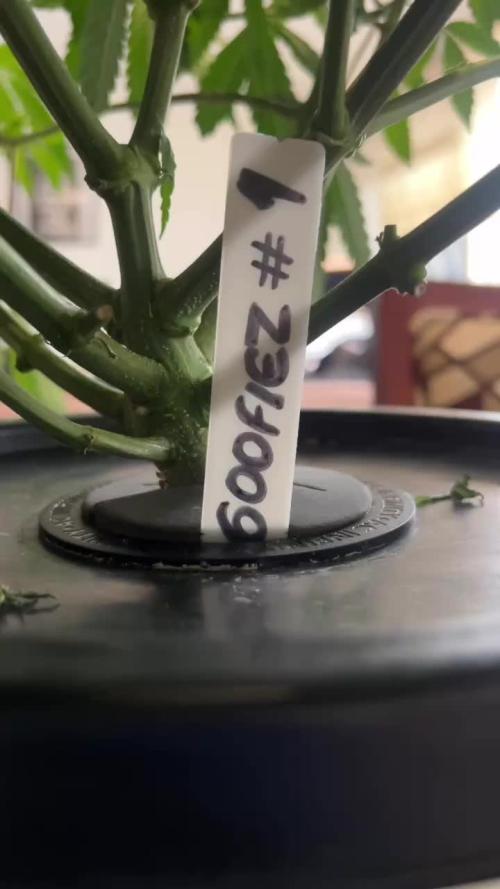The Grow Awards 2026 🏆 



































Likes
Comments
Share


@Fonzi
Follow
Es läuft ganz gut aber die pflanzen werden bisschen blass, muss ihnen in der folgende woche vielleicht bisschen bitetrsalz geben.
Likes
79
Share


@Salokin
Follow
Hello Growmies! 🌿👋
Welcome to Week 17 of our Epic Buzz journey! We're observing some noticeable progression in our plants, and we're nearly at the finish line with the next entry poised to be our final harvest week!
Here’s the breakdown for our Epic Buzz phenotypes:
Pheno #1 is thriving with its buds thickening up nicely, showcasing a frosty appearance that promises high-quality resin production.
Pheno #2 remains a bit smaller in comparison, yet it's catching up with an increase in bud density and trichome development.
Pheno #3 stands out with its robust growth and resin-packed buds that are slightly ahead in terms of maturity compared to its siblings.
As we approach the harvest, maintaining optimal environmental conditions—consistent humidity and temperature—is more crucial than ever to maximize their potential.
Stay tuned for our final week's update, and as always, stay lifted! 🚀🌱
Likes
25
Share


@Grower_Of_Persia
Follow
week intel:
we getting close to end of ripening , this week i raised drought , Nitrogen and E.C stress by feeding them 2 times per week and raised e.c to 3 to cause real stress that will help increase terpenes production
stresses :
Nitrogen deficiency Stress by removing the fertilizers that has N in them
Drought stress via removing one meal in week
high E.C stress around 1.7 and the other feeding day 3.0 , 2 times a week
feeding:
no more Nitrogen
i feed them 2 times this week with this order :
day 1 : i feed them high with Bio-Bizz Top-Max + Feeding Booster about 850 ppm - 1.7 e.c to cause a medium e.c stress.
day 3 : no more feeding this day
day 5 : i feed them very high dose of Bio-Bizz Top-Max + Feeding Booster around 1500 ppm - 3 e.c to cause high e.c stress
guide of the week :
be patient in the last weeks, never hurry for harvest because its the time of ripening in last 2 weeks you should let plants to do their work
last weeks of ripening is the time to break the limits we should cause 3 stresses as i said above Nitrogen stress , Drought Stress , E.C Stress
Likes
44
Share


@Chedderbob112
Follow
Waiting on a full plant hang dry so will wait at least two weeks maybe three hope ma vegging station holds up n can dae tge damage the now as av said guys this is definitely not the perfect set up am not on good terms with land lord so basically squatting here lol and growing and a got caught with one in this house the land lord doesn’t even know lol 😂
Likes
5
Share


@HafastMotorsports
Follow
4 of the 6 look promising. Things are revegging so it's whatever nature decides. Added bonus vid of this strain indoor.
Likes
3
Share


@kdifiori_
Follow
It's harvest week for Pineapple, Skunk, and little Gorilla Strawberry, which I put in the room together for two days of darkness before harvesting. Cheese is getting heavier and heavier due to its stem, and unfortunately one flower has broken, but luckily it won't be long for her either. Bubblegum has been a wonderful surprise given how it started, and it too is a little monster. I'm really proud of my girls!
Processing
Likes
9
Share


@JakeTheButcher
Follow
It was an interesting week...nice to have something to keep my mind occupied on these girls during this covid-19 epidemic.
2 days after water change last week, my roots started to turn brown and have appeared to stop growing, I first was concerned that it was root rot, but the plants didn't seem to be affected. So I added more UC ROOTS to the solution in hopes that it would help, I noticed white roots shooting out about 24 hours after. I think it may have been the increase in the coco cal that did the damage. They are filling the net nicely and I will be flipping them to flowering this week I think.
Likes
24
Share


@TerpTurtle
Follow
Strawberry Truffle - White Truffle x Red Pop & limited seed it came with Chem 91 x Red pop
Likes
Comments
Share


@dirtjumper75
Follow
Y Griega and Gelato Ice Cream are approximately 2 weeks ahead of the rest of the plants in flowering. Adding 1 teaspoon of Blackstrap Molasses every watering and fertilizer every other watering.
Likes
12
Share


@Seymour_buds
Follow
girls are growing well. changed water change out cycle to replacing 1/3 of entire resevoir every 3 days. The theory is that i will be able to transition changes to nutrients slowly to identify any changes to the girls.
one girl showing sign of what i believe to be calcium deficiency.(picture attached)
Likes
9
Share


@HUMO_Cultiva
Follow
Update day 10 of transition to bloom this Goofiez 2 it’s soy strong !!
Processing
Likes
12
Share


@Silverback_Guerilla
Follow
1/14:
This morning, I did a foliar application of big bloom and fulvic acid, then about 5 hours later I watered them with about a half-gallon of rainwater each and added armor si, humic acid, endoboost myco/tricho, liquid molasses, and a bunch of cal-mag. Today, I also I wired up and mounted my new samsung sun board strips (660nm/730nm) and my Solacure FlowerPower UVB fixture.
I'm running the deep red/far red bud boosters a few hours per day right now, but will run them for the entire photoperiod once I start flowering them. I'll run the UVB for 4 * 15-minute sessions a day for the full flowering cycle, and if they don't protest too much I'll increase each session by 5 minutes and evaluate again. Some strains are more forgiving than others and I've got 5 different strains in this space...so really not sure much time I'll get away with exposing them to the deadly rays without damaging them too much...😈
1/15:
I received one of the rapid led/growmau far red initiator pucks today. With the placement of my UVB light, I'm realizing I'll need another far red puck to have even and intense far red coverage, so I'm ordering another with Prime delivery and waiting to start flowering until I receive it.
I sprayed them down really well with ph adjusted rainwater tonight to rinse off nutrient build-up from foliar applications.
1/16:
I'm really excited to try flowering under 14/10. I grew photos indoors on an off for 15 years before I semi-retired. If I added up all the additional flowering time I could have done through the years if LED technology existed, I'd have had an extra truckload of bud to smoke.
I did another application of Axiom Harpin a|b Proteins this evening, right before dark. I'm expecting a big growth burst this week, leading up to the flower stretch. I really need them to trigger under 14/10 within 4 or 5 days🙏
...if not, I'll switch to 13/11 and wait a few more days🙏😟..if still no pistils are poppin, I'll go to 12/12 and chalk it up as bad luck or varietal indifference to Pr and Pfr manipulation.
1/17:
I fed each of them about 3/4 gallon of full strength veg nutes. This will be the last. I'll go with half-strength veg and half-strength bloom for a week, then go with full strength bloom nutrients until I start flushing them in 6-8 weeks.
1/18:
I installed the second far-red flowering initiator today and got all my timers configured for flowering:
=========================================
timer#1 - power strip with qb's and red boosters
10:00am -12:00am
timer#2 - (dual/independent setting)
sideA- 3-way cube with uva bars
10am - 3pm
7pm - 11pm
sideB- flowerpower uvb
1pm - 1:15pm
4pm - 4:15pm
7pm - 7:15pm
11pm - 11:15pm
timer#3 - far red pucks
11:00pm - 12:15am
timer#4 - sub-canopy tube
10am - 1pm
3pm - 6pm
8pm - 11pm
========================================
I also did some testing on the timers and sealed myself into the closet to check for any light leaks. All good.👌
1/19:
Tonight is their first long night. It's ON!👍
1/20:
I watered them today with about a half gallon each. I'm seeing calcium and magnesium deficiences here and there, so added some boomerang and heavy cal-mag-Fe along with liquid molasses, humic acid, and endoboost myco. I also foliar fed with big bloom and fulvic acid.
That's it for week 4-
Likes
18
Share


@GreenCasual
Follow
Started flushing. Buds are getting tough, most pistils are turning brown and some trichromes are already amber.
I harvested the two bigger stems on Wednesday (because their sugar leaves were getting yellow and crispy) ; will harvest the rest of the plant on Saturday !
Likes
18
Share


@raulmoat123
Follow
Quick update week 3 flower these girls are putting on weight very very quickly. The blue gelato buds are already becoming dense like stones . Watermelon punch literally is the most satisfying smell I have smelt in a while . Wedding cake is the biggest in my tent and most gassiest plant. The terple inhouse genetics are also massive will show the inhouse section next week , just takes to long to take them out of tent
Likes
15
Share


@MG2009
Follow
Will keep a mother plant.
Beautiful plant, probably needed more food. But it produced a good night medicine, very relaxing melt into your couch and grow roots out your as cause you won't be going anywhere soon.😑
PS. Smoke report was for first plant harvested the smaller one. And she's not even cured yet, can't Wait to see how second plant harvested bigger one turns out I let her go 60% amber 30% cloudy and 10% still clear trichomes. Pros, she will let you relax, good night med. Still curing plant 2 but feeling stoked Earlier cut was less amber still good sleeping. Can only get better meds at 60% Amber should be fire🔥🔥🔥🔥🔥🔥promise to update after testing out. Maybe 3 weeks I hope I can wait !😬0
Plant #2 dried four days, till stems almost crack, been jarred up in glass for 1 week burping jars as needed, 2 weeks till 1st test smoke plant #2. See you in 2 weeks
peace out.
Wow 2 week's already?
02/07/2018
Still a little moist. Smoking a little bit high hit me fast. Taste blah back to jar.🙏
Likes
28
Share


@Roberts
Follow
This was a lost grow from dudding disease that got brought over from another run, it did not come from AMS. Plants were destroyed. Thank you Spider Farmer, and AMS. 🤜🏻🤛🏻🌱🌱🌱
Www.amsterdammarijuanaseeds.com
Thank you grow diaries community for the 👇likes👇, follows, comments, and subscriptions on my YouTube channel👇. ❄️🌱🍻
Happy Growing 🌱🌱🌱
https://youtube.com/channel/UCAhN7yRzWLpcaRHhMIQ7X4g
Spider Farmer G300w: https://amzn.to/3S2zvsd
Spider Farmer 10X20 Heat Mat Kit - https://amz.fun/lsa0J
Spider Farmer Amazon Store: https://www.amazon.com/spiderfarmer
Spider Farmer Official Site: https://spider-farmer.com
Discount code: saveurcash
Likes
5
Share


@CannaBossBizz
Follow
Yesterday i took off some Leafs down there.
Looks Like a Bouquet now 😄
She's responding great to the Training i have her. I'm pretty exited how she'll do in the Future weeks 🤙🏽
Likes
4
Share


@Budking420
Follow
These ladies are already beginning to pre flower strong. I'm super excited to see what one yields more the square 3 gallon or the round 3 gallon. Check back next week to see just how fast they bud & remember its 4:20 somewhere!!!!!

























